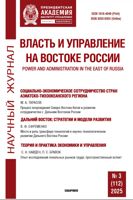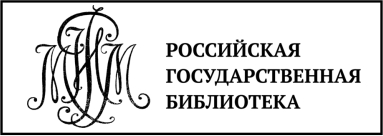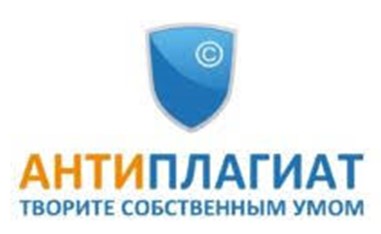Contents. №3 (68) 2014.
< briefly >
| № | Authors |
Article name |
File |
|---|---|---|---|
Far East of Russia: new approaches and instruments of public administration | |||
| 1. | N.M. Baykov | How to live and manage in the Far East of Russia: new approaches and instruments of public administration | |
Materials of the next meeting of the discussion club organized by the Interregional public organization "The Far-Eastern national academy of sciences", the Khabarovsk regional department "Russian geographical society" are presented in the publication, by the Khabarovsk regional association of businessmen, the Far-Eastern chamber of commerce and industry, the Khabarovsk regional office "The Russian society of sociologists", Non-profit partnership “FEIR of the market, NOU VPO "The Far-Eastern institute of international business" and the Far-Eastern institute of management – RANEPA branch by the President of the Russian Federation. The State program of social and economic development of the Far East and the Baikal region, approved by the Government of the Russian Federation became on April 15, 2014 the main subject of discussion. Consequences of its realization for social and economic development of the Far-Eastern territories and a standard of living of people populated them are emphasized and proved.
| |||
| 2. | V.N. Shiyan | The Far-Eastern guidelines of Russia. | |
Enclavization of the territory of the Far East as its specific social and economic state is marked out in the state program of development of this macro-region. In the research of such specific phenomenon for the first time marked by the government bodies of the Russian Federation, conditions of its formation, reasons of the formation and overcoming measures actively joined the scientific community of the region, having united on the basis of debatable club by RANEPA DVIU. Such position of the scientists deserving support from the government bodies and civil community, allows not only to investigate the specific demographic situation of macro-region menacing to the national security of the country, but also to form the new social institutes of its overcoming.
| |||
| 3. | N. M. Gorbunov | Investment appeal of the border regions of the south of the Far East. | |
In this article the main directions of development of economy and investment appeal of the southern subjects of the Russian Federation of the Far East are considered. The policy of the Russian state concerning the Far-Eastern regions is presented. Adopted by the federal and regional public authorities of the decision on an increase of investment appeal of the subjects of the Russian Federation are allocated. The possibility of research of the investment processes in the southern regions of the Far East united in one group is proved. As competitive advantages of the Far-Eastern southern regions the richness of subsoil, proximity to the markets of the countries of the Pacific Rim, development of the transport system and realization in their territory of the large projects is determined. The factors influencing investment appeal are allocated, classification of them is carried out, main measures for an increase of their efficiency are given. The reasons of the lack of steady growth of investments in the southern regions of the Far East are determined. Opportunities and mechanisms of improvement of the investment climate in them are considered.
| |||
| 4. | V.F. Efremenko | Creation of the new workplaces in the hi-tech sectors of economy: prospects of the Far East of Russia and the foreign experience | |
The growth of investments into the branches of mining industry of the Far East of Russia is characterized by the high rates of return on the invested capital, but doesn't lead to creation of the new workplaces. The processing branches creating the attractive workplaces for all categories of the population have an acute shortage in investments. Taking into account experience of the USA on creation of the hi-tech economy, the need of transition to a new industrial model in the Far-Eastern region is proved.
| |||
| 5. | E.A. Frolova | The role of civil society in the process of cross-border cooperation in the Far East | |
The author made an attempt to draw attention to the institutions of civil society as to an important resource of diplomacy, and also a problem of use of the national (public) diplomacy in the course of cross-border cooperation in the boundary space of the Far-Eastern federal district. At this moment cross-border cooperation is one of the ways of maintenance and development of the relations with the adjacent states, an increase of permeability of the space on the both sides of the border. The analysis carried out by the author of the article allows reveal a number of features of participation of the representatives of civil society in the process of cross-border cooperation in the Far East, to draw the directions and forms of this cooperation. Proceeding from this analysis, the author made a number of practical recommendations about the research problem.
| |||
| 6. | M.A. Gritsko | Human potential of the Far East: modern dynamics and growth restrictions | |
The article analyzes the current level of human development in the subjects of the Far East on the basis of data on the Human Development Index. The study shows that the most problematic component of forming human capital is the low level of population health. An explanation of the reasons for the low life expectancy of the Far East, among which are the demographic, socio-economic and spatial characteristics is offered.
| |||
Economy | |||
| 7. | O.G. Ivanchenko M.S. Kudaeva |
Development of the institutions of financing of economic activities of the enterprises in the real sector of economy | |
In recent years, in the Russian Federation as a whole, and in the Khabarovsk territory as well, there is a tendency to strengthen the influence of the raised funds in the structure of the non-financial enterprises capital. Attracted capital is necessary for the majority of enterprises for the development and formation of the investment base as their own resources are, as a rule, insufficient. There at, the measures of state support and the institutions for financing the activities of the enterprises considered in the article have been obtaining particular importance. Institutions for financing are subdivided into the state ones and the financial and credit ones. The state institutions for financing include the budget and the institutions for development. For development of the enterprises measures of the state financial support that include measures to support small enterprises and to invest the activities of non-financial enterprises in the Khabarovsk territory are also important. Banks and the micro-financing enterprises are assigned as the main financial and credit institutions that render an essential role in investing activities of the enterprises. But, because of certain restrictions, their activities hasn’t yet raised to the scales demanded by the economy. Existence of the state and financial and credit institutions to finance the financial and economic activity of the enterprises under the modern conditions is the most important component of the economic growth of Russia. | |||
| 8. | S.N. Tret’yakova | Some recommendations about improvement of "The main directions of the uniform state monetary policy" | |
Today there is a radical restructuring of theoretical and methodological bases of formation of a monetary policy in Russia. The counter-cyclic approach aimed at providing financial stability becomes a basis of regulation of the monetary sphere. On this platform macro-prudential supervision which allows unite various activities of the central bank is formed. Macro-prudential supervision uses tools of a monetary policy and bank micro-prudential supervision. Relevance of information openness and transparency of monetary policy in the conditions of transition to a mode of inflationary targeting grows. Thus current trends in regulation aren't reflected in "The main directions of the uniform state monetary policy". Recommendations about improvement of the main public document of Bank of Russia are presented in article concerning monetary regulation. Offered changes according to the contents of the document, approaches to its logical construction, updating of the name are proved.
| |||
| 9. | V. K. Zausaev A.I. Vorob’eva |
The value of productivity of municipal economy for the population | |
The article considers the productivity in municipal enterprises of Khabarovsk. The role of labor productivity is examined in the task of securing and attracting people to the Far East and in Khabarovsk. Need to accelerate the growth of labor productivity is justified primarily in the municipal sector. The analysis is performed of the dynamics of labor productivity in relation to the dynamics of changes in wages, as well as an increase in tariffs. The need is confirmed for priority to stimulate productivity growth and the introduction of the dependence of growth of real wages from changes in productivity in the municipal sector of the economy. Interdependence is justified changes in productivity, wages and rates of municipal enterprises and the quality of life of the population of the municipality.
| |||
| 10. | I.V. Zhukova | Assessment of investment efficiency of the working mining projects | |
In this article the features of assessment of the objects of intellectual property in the subsurface use – a type of business activity where the state always participates as the owner of subsoil are considered. The author considered technologies of extraction of the useful components from ores of the Komsomol’sk tin-bearing district. By the means of comparative method the assessment of the objects of intellectual property is carried out, results of an assessment of technologies taking into account the investment appeal are given. The author notes that in the sphere of subsurface use there is no practice of estimation of the cost of the property rights to natural objects. The author also underlines that there are no developed methods of economic evaluation of the rights in relation to the mentioned resources.
| |||
| 11. | E.V. Bogomolova S.V. Sidorenko |
Application of preparations from peat by the treatment of children’s diseases in the Khabarovsk territory | |
The article acquaints with the condition of application of peat preparations by the treatment of children's diseases which has developed in the Khabarovsk territory. Using them is caused by the requirement of involving in the practice of public health services of the effective remedies, allowing using the modern innovative methods of treatment. Application of preparations from the peat which manufacture is mastered in the Khabarovsk territory, allows solve more successfully a problem of treatment of children's diseases in the local institution of public health services that weakens intensity with their inaccessibility in the western regions of the country. The received positive results of application of peat medical preparations in the aggregate with ample opportunities of the further perfection of this practice allow consider it as one of the perspective directions of recovery of the health of children.
| |||
| 12. | U.V. Dudina | Justification of development of the cadastre of fauna resources of the Khabarovsk region | |
The importance of natural and resource potential by the example of the Khabarovsk region is considered in the article. The need to maintain the stability of resource base for ensuring stable functioning of economic system of the region is discussed. Justification of creation of databases to display condition of animals and their habitats in the territory of the Khabarovsk region is given. The conclusion that protection of fauna leads to direct preservation of natural and resource potential of the region is formulated. Drawing up the regional cadastre of fauna resources is offered as the main measure to ensure stability of resource potential of the Khabarovsk region. Justification of the necessity of development of the cadastre is also given.
| |||
History and the present | |||
| 13. | E.N. Gnatovskaya | Party «purges» of the railroad workers in the Far East in the 1930th | |
In this article the emergency measures of personnel policy concerning the railway transport workers of the Far East – members of the All-Union Communist Party (bolsheviks) in the conditions of militarization and modernization of the USSR in the 1930th years are considered. The author reconstructs the atmosphere and a course of purges on the example of concrete enterprises of the railway transport, and also reveals the motives and socio-political orientation of the purges. In the article the conclusion that the purges were the universal mobilization and political instrument is formulated. Creation of the new model of party became the result of purges: oligarchical in the center and marginalized on the places.
| |||
| 14. | I.A. Krasnoshchyokov | Development of the control system of border troops of the People's Commissariat for Internal Affairs of the USSR before the war with Japan (on the example of the Primorsk boundary district of the People's Commissariat for Internal Affairs of the USSR) | |
In this article the control system of border troops on the example of the Seaside boundary district of the People's Commissariat for Internal Affairs (PCIA) of the USSR is considered. The organizational structure of troops including the structure of the staffs is given, questions of ensuring the military operations are reflected. Special attention is paid to the aspects of communication preparation before the offensive operations. The main information was transferred on telecommunication, radio communication had auxiliary character.
| |||
| 15. | A. S. Larioshin | Social and political factors in the USSR and conditions of the Soviet pedagogical science in the second part of the 20th actualized the development of the pedagogical problem of readiness of the students for multicultural communication. | |
The article is devoted to analyze of internal and external factors which made the pedagogical problem of students’ readiness for multicultural communication topical in the USSR in the second part of the 20th century. The author uses cultural-historical and civilizational approaches for a detailed analysis of external and internal factors actualized the development of pedagogical problem of readiness of students to multicultural communication in the Soviet Union during the second half of the XX century. The results are summarized in a table which illustrates the relationship of factors in different aspects. The table makes possible to track predictors of socio-cultural problem (the problem of readiness for multicultural communication) resulting pedagogical problem (the problem of students’ readiness for multicultural communication).
| |||
Sociology, philosophy, culturology | |||
| 16. | I.I. Dokuchaev | Values and social/legal norms as the culture forms | |
The paper examines the role and place of values and social legal norms within the system of human culture. Among regulative factors of social interaction we consider: existential values, practical utility and social norms per se. We demonstrate that ‘values’ and ‘norms’ are not the same thing if we judge these categories by the respective scope of artifacts they cover. Value and usefulness underlie a social norm, while the latter in its turn can be regarded as an 'emasculated’ value drained of its existential nature. The author puts in question the rationalized and practical nature of social norms, since their axiological content never disappears altogether. The author suggests a classification of social norms based on such criteria as ‘formalization/non-formalization’ and ‘legitimization/non-legitimization’; the classification includes the following types of social norm: customary practices, prescriptions, morality and laws.
| |||
| 17. | N.M. Baykov | Labor migrants in the rural society of the region: features of the social and economic interaction with the local population | |
This article presents the analysis of the objective and subjective sides of labor migration in the rural society of the Khabarovsk territory. According to the official statistics, international labor migration in the region has increased substantially, especially from the Central Asian FIC countries, which gives the rise to different models of the social and economic interaction of foreign citizens with the local population. In this case, the main flows of labor migrants settle in the urban areas or near their area. Meanwhile, the need for labor resources is largely expressed in the countryside. Based on the analysis of the narratives of migrant workers in the article the characteristics of different types of the life forms of exchange with the local population, their influence on the development of social relations in the rural society are shown.
| |||
| 18. | E.S. Mikhalat | Characteristics of the higher educational services as the social and economic categories | |
Transformation of the Russian economy to an innovative way of development in order to increase its effectiveness involves qualitative and structural changes of the including in education. Effective market of educational services is a prerequisite for the implementation of the government strategy focused on achieving a high level of production and the country's competitiveness in the world market. To the study of the problems of the education market it is necessary to determine the main concepts and their specificity. Concepts such as "educational services" and "education market" have become part of the theory of economic science. However, it should be emphasized that in the scientific literature and publications there is no definite response, how to understand their essence.
| |||
| 19. | I.M. Voronina M.Y. Khaustov |
The problems of formation of professionally important qualities and competencies for the development of entrepreneurial potential of the students | |
The article examines the role of university in the process of entrepreneurial potential of the students. Based on the theoretical analysis, the authors presented a three-level model of entrepreneurial competencies. Considering the formation of student’s special competence of entrepreneurship, the authors analyzed the curriculum all of directions, as well as the results of SWOT - analysis leads to the conclusion for formation of educational space institute to develop the entrepreneurial potential of students.
| |||
| 20. | L.V. Sinitsyna I.N. Tsupko |
Considering socio-psychological aspect in organizing the process of work with the heads of National communities of small indigenous peoples of the North of the Khabarovsk territory | |
The policy of steady development of small indigenous peoples of the North is aimed at strengthening their social and economic potential, preserving cultural values, traditional lifestyle and preserving their native habitat. The policy is based on the target state support and mobilization of internal resources of the peoples. The heads of the national communities play a great role in the solution of the most acute problems. The heads of the national communities of the North of the Khabarovsk territory underwent psychological diagnosing during a field seminar, which was held in June 23 – 25, 2013 in Komsomolsk – on Amur. The article presents the results of the investigation which allow to point out the main features of their character and to draw a psychological portrait of a typical head of a national community. The following methods have been used: «Psycho-geometrical test (S. Dellinger) », «Nonexistent animal» test, «Web» test , «Two Rings» test, «Road» test, «Going Through the Woods» test. Recommendations for the heads of small indigenous people’s communities have been worked out.
| |||
Law | |||
| 21. | V.V. Filippov | Counteraction to corruption in Singapore | |
The article describes the most significant features of Singapore's anti-corruption policy made for significant performance in combating corrupt behavior by government officials and private sector officials. At the heart of such a policy is developed legislation imposing a ban on the use of official position for personal gain and getting of illegal material and immaterial benefits including protectionism and patronage. Also important is the presence of a specialized state law enforcement agency having special duties to detect and investigate corruption offenses in all spheres and sectors of society Singapore. To influence the behavior of officials in the official structure of the Government of Singapore the Singapore Public Service Commission acts and it targets to control for Standards of Official Conduct by state officials of all branches of government and at all levels of government and administration.
| |||
| 22. | E.A. Kiselyov E.Y. Kazachyok |
On the question of the importance of personal planning of the investigator as a way for improving of the effectiveness of crime investigation | |
The effectiveness of any activity largely depends on its proper organization and planning. Investigative activity isn’t exception. Depending on to what extent as an investigator will organize activity for personal planning so activity for investigation of crimes will organize generally. In this article there is a proposition of the new approach to the personal work planning of the investigator. There are recommendations on the work activity, improving of the investigative bodies’ investigators, leading to the improvement of investigation of the crimes’ efficiency.
| |||
| 23. | R.M. Kashapov | Comparative and legal analysis of the domestic and foreign legislations for crimination of the obviously innocent | |
The article is devoted to the comparative legal analysis of the criminal legislation of Russia and foreign countries, on the example of Japan, South Korea, China, Turkey, for a crimination of the obviously innocent. According to the author, giving by the accused false testimonies in which he criminate the innocent person, has to attract criminal liability for obviously false denunciation (Art. 306 of the criminal code of Russian Federation (CCRF)). The author considers crimination of the obviously innocent as one of the types of the negative post-criminal behavior counteracting disclosure and investigation of a crime. The author offered the need of establishment of criminal liability for crimination of the innocent person and the draft of the article 306 of CCRF / performance, crimination, artificial creation of proofs of the obviously innocent person and falsification of the proofs of charge.
| |||
Post-Graduate Research | |||
| 24. | A.V. Makovskiy | Soviet bodies of the border and customs control in the Far East (the first half of the 20th of the XX century) | |
In this article the author considers the process of organization and development of the bodies of border and customs control in the Soviet Far East taking into account the military-political and economic and social situation of the region after the end of the Civil war and the foreign military intervention. Difficulties which arose during this process, their reason, conditions and measures undertaken by the country leaders and the region on their permission are analyzed. The author touches some questions which are directly concerning the organization of control by the specified bodies of crossing of the frontier by the persons, vehicles and freights in the places which are specially established for these purposes – check points. Some aspects of interaction between the boundary and customs divisions are covered during implementation of the powers by them on the control on the frontier.
| |||
| 25. | A.V. Alekhin | Management of innovation projects: Australian experience | |
Management of innovation projects is one of the most popular activities of the modern companies. The main difference between innovation projects from traditional project management is that they exist under conditions of high risk and uncertainty. Thus, risk management is an essential part of the process in this context. In order to provide all the necessary information to stakeholders it is essential to make a deep analysis of the external investment environment and the internal capabilities of the company. Risk management can increase attractiveness of the projects. This article considers the experience of Australian steel manufacturing companies. After this, the main risks are identified and the actions to avoid or minimize them are mentioned.
| |||
| 26. | D. N. Cherniavskaya | Efficiency estimation of the control and supervising activity of the territorial authorities of the Federal Antimonopoly Service of Russia (on example of the Far-Eastern federal district) | |
The article presents the results of studies of the analysis and estimation of efficiency of the state and municipal control. Key provisions specifying the need for changes of approaches to an estimation of efficiency of the control and supervising activity are given. The study concluded the author offered indicators of an estimation of efficiency of the control and supervising activity, calculated on the example of territorial authorities of Federal Antimonopoly Service of Russia in the Far-Eastern federal district.
| |||
| 27. | E.M. Tertyshnikova | Features of development of the norms about the outrage upon bodies of the dead and places of their burial in the domestic legislation of the XI – XVI centuries | |
The article is devoted to the analysis of the norms providing responsibility for commission of the outrage upon bodies of the dead and places of their burial in the Russian criminal law. During the author’s research the unique lines inherent in the secular and church legislation of the period of the XI-XVI centuries regarding the regulation of responsibility for commission of the acts, connected with the violation of bodies of the dead and places of their burial were revealed. The author comes to a conclusion that at the first stage of historical development the specified norm didn't gain distribution within the secular legislation, however, was provided by an ecclesiastical law. The attention to that the norms of an ecclesiastical law had a great impact at the initial stage on the development of domestic legislation concerning the crimes connected with the violation of bodies of the dead and places of their burial is paid.
| |||
| 28. | V.N. Skorik | The place and role of investigative situations in the organization of investigation of illegal crossing of the frontier of the Russian Federation in the check points | |
The article is devoted to the problem questions making a methodical and tactical basis of the criminal procedure actions at the implementation of verification of the message on a crime and carrying out investigative actions at an initial stage of investigation of the illegal crossing of the frontier of the Russian Federation at the check points. Considering a wide range of procedural actions which are carried out within the verification of the message on a crime, there is a need of development of methodical recommendations and fixing in them tactical features of investigation, thanks to which the quantity of errors of criminalistics character will be reduced and the crime detection will raise. In this article the most typical initial investigative situations are covered, the author formulated their definition, the place and a role in investigation of these crimes are given, the problem elements meeting in the investigative practice are considered, the ways of optimization of activity of the investigators and an increase of efficiency of investigation of the studied crimes are offered.
| |||
| 29. | M.V. Moskvitin | Municipal regulation of housing and public utilities through the cold-water supply and sanitation tariffs setting | |
This article is focused upon the problem of legal recognition of the housing and public utilities regulation process through cold-water supply and sanitation tariffs setting. The author pays special attention to the Municipality’s role in the solution of the issue above and to the law enforcement practice in the Far-Eastern federal district, Jewish Autonomous Region, the Khabarovsk territory and the city of Khabarovsk, in particular. The following issues were raised by the author: the utility of the tariffs calculation rules changes made by several by-laws; the role of the Municipality in taking investment programs, as well as the role of the municipal entity as a regulator of relations between the supply organizations and consumers. The article describes the special features of the methodology of tariff regulation in the housing sector. The procedure for consideration and approval of production and investment programs of public utilities is taken as the object of the research. The problems of the tariffs setting procedure are considered and recommendations are also given by the author.
| |||
| 30. | V. E. Maryzhikhin | Military costume and weapons of the Russian Imperial army during the Russian-Japanese war | |
The present paper considers the peculiarities of military costume and weapons of the Russian Imperial army during the Russian-Japanese war of 1904 – 1905; classification of the uniforms and weapons of the early 20th; factors that influenced their evolution are analyzed. The fact of rethinking the military experience as a result of many months of fighting, and, as a consequence, the change of methods of formation of the military service and the military weapon systems are explored. In addition, special attention is paid to the study of such group of weapons, such as machine gun "Maxim"; functions that it performed at the moment of appearance in the Russian army and the reasons that by the end of the war led to the understanding of the exceptional value of the machine gun in the upcoming hostilities are studied.
| |||
| 31. | S.V. Galitsin | Economic situation in the Far East of Russia upon termination of the Civil war and the intervention | |
The article is devoted to the economic situation of the Far East upon termination of the Civil war and the foreign military intervention. In it the most affected branches of economy of the Far East come to light, the statistical data characterizing the changes which affected national economy of the territory are analyzed, the measures taken by the new Soviet power and directed on the overcoming of pernicious consequences of military operations in the territory of the region are considered. The influence of neighboring states on the rates of development of some branches of economy of the territory, expansion of personnel structure of the bodies and institutions responsible for carrying out the recovery actions are noted. The post-war condition of the heavy and mining industry of the Far East, and also the actions of authorities directed on optimization of the activity of industrial enterprises of the Far East is separately considered. The author formulates a conclusion about the delay of recovery of the economy of the Far-Eastern region and the direct dependence of this process on the volumes of its financing from the authorities.
| |||
















